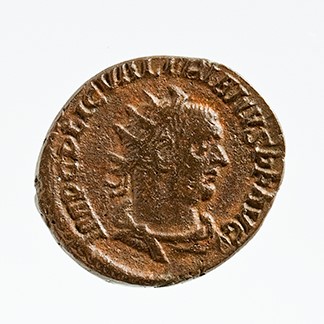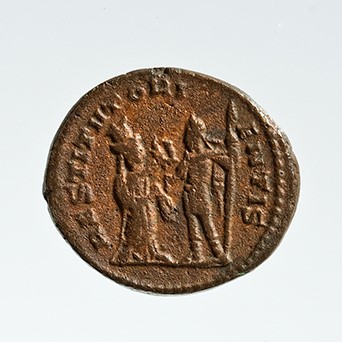Acquisition number: 1986.14
Obv.: Bust of Valerian, r., radiate, draped. IMP(erator) C(aesar) P(ublius) LIC(inius) VALERIANVS P(ublii) F(ilius) AVG(ustus).
Rev.: Female with turreted head-dress (the cities of the Orient) standing r., presenting wreath to emperor standing l. and holding spear. RESTITVT(or) ORIENTIS (‘restorer of the East’).
Title: Antoninianus of Valerian - 1986.14
Acquisition number: 1986.14
Author or editor: Beryl Rawson
Culture or period: Roman Imperial
Date: AD 255-260
Material: Metal - Copper-silver alloy
Object type: Coins - Roman
Dimensions: 20mm (w)
Origin region or location: Türkiye
Origin city: Antioch
Display case or on loan: 7
Keywords: Coin, antoninianus, Roman, Imperial, Valerian, Syria (Roman province), Roman Syria
Sear, D.R., Roman Coins and their Values 5 vols (London, Spink, 2000-2014) 9967; Seaby, H.A., Roman Silver Coins (London, B.A. Seaby, 1967) 189.
1986.14
Antoninianus of Valerian
3.03 g. AD 255-260
Obv.: Bust of Valerian, r., radiate, draped. IMP(erator) C(aesar) P(ublius) LIC(inius) VALERIANVS P(ublii) F(ilius) AVG(ustus).
Rev.: Female with turreted head-dress (the cities of the Orient) standing r., presenting wreath to emperor standing l. and holding spear. RESTITVT(or) ORIENTIS (‘restorer of the East’).
Minted in Syria.
The antoninianus coin was introduced by Caracalla early in the third century and became the commonest in circulation. The silver wash over copper has been lost from this example of the coin.
Valerian became emperor in AD 253 after a bout of civil war. His son Gallienus was recognised as co-emperor. It was a time of increasing pressure on Rome’s borders. Gallienus took responsibility for the west, and Valerian went east in AD 254 to hold back incursions, especially of the Persians into Asia Minor. In AD 259 Valerian was captured and he died in captivity in 260.
Coins hailing victories were numerous in this reign, many of them reflecting hope rather than real successes. Here the personification of the East offers Valerian the wreath of victory. The coin was probably issued from Antioch, but some of this type were also issued from Rome. The type and the long obverse legend suggest a date early in the reign, AD 255-257. (See Mattingly and Sydenham V.1 Introduction.)
Sear, D.R., Roman Coins and their Values 5 vols (London, Spink, 2000-2014) 9967; Seaby, H.A., Roman Silver Coins (London, B.A. Seaby, 1967) 189.

